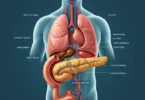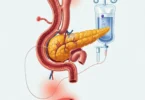Symptoms of Pancreatic Cancer
Pancreatic cancer shows no symptoms over long time or only mild symptoms that may be signs of comparatively harmless diseases. Since no typical symptoms or warning symptoms are present in the early phase of the disease therefore pancreatic cancer is usually discovered very late. Symptoms occur only when the tumor is so large that it hinders the production or the flow of digestive enzymes or the tumor has spread to other organs. For example, a jaundice come when the tumor blocks the bile duct and bile can no longer flow into the small intestine. In jaundice, the skin and the whites of the eyes are yellowish. The urine is dark, the chair light. In addition, a generalized itching occurs.
Other typical symptoms are:
- Nausea, vomiting
- loss of appetite
- Indigestion: diarrhea, constipation
- unintentional weight loss
- Pain in the upper or middle abdomen area
If the tumor has reached a certain size or has spread to nearby lymph nodes, liver or lungs, it can cause severe pain in the upper abdomen. Also back pain can occur because the pancreas is immediately in front of the spine.
Some tumors may also block vein, block the blood is transported from the spleen. As a result, enlarged spleen, and it can arise varicose veins near the stomach and esophagus. When this burst, there is severe bleeding, especially from the esophagus.
Additionally, you experience hormonal imbalances when the tumor is from in hormone producing tissues ( endocrine pancreas ) . These rare tumors form hormones in excessive amounts. Depending on the hormone pancreatic cancer is distinguished as:
Insulinoma
The most common pancreatic endocrine tumor is insulinoma. This benign tumor produces uncontrolled insulin so that the blood sugar level falls (hypoglycemia). Symptoms of insulinoma include:
- Sweating, tremor
- Palpitations, nervousness
- debility
- Big hunger
The low blood sugar levels can even lead to loss of consciousness to convulsions and coma.
Gastrinoma
A gastrinoma is a tumor of the pancreas, which produces large amounts of the hormone gastrin. It stimulates the stomach to secrete acid and digestive enzymes. The overproduction of gastrin can cause gastrointestinal ulcers and cause diarrhea, severe abdominal pain and internal bleeding. About half of gastrinomas is malignant.
Glucagonoma
A Glucagonoma is a tumor of the alpha cells of pancreas in which glucagon hormone is produced in large quantity. Thereby, the blood sugar level increases. A typical feature of a Glucagonoms is a characteristic scaly, red-brown rash. It starts in the groin and spreads out on the buttocks, underarms and legs. The tongue is smooth and shines orange, often the mouth are torn. Most of the Glucagonomas is malignant, but they grow slowly and are extremely rare.






